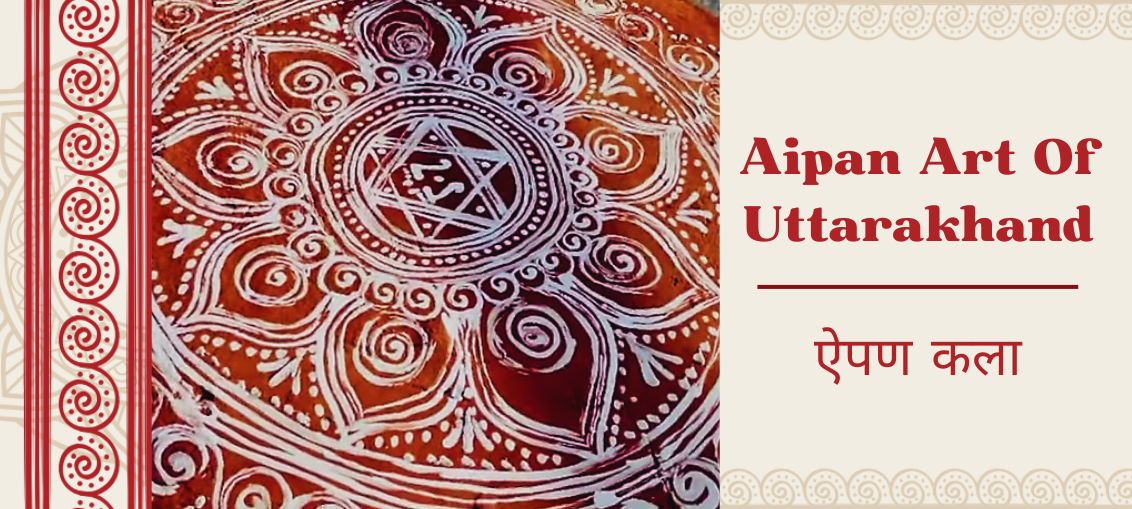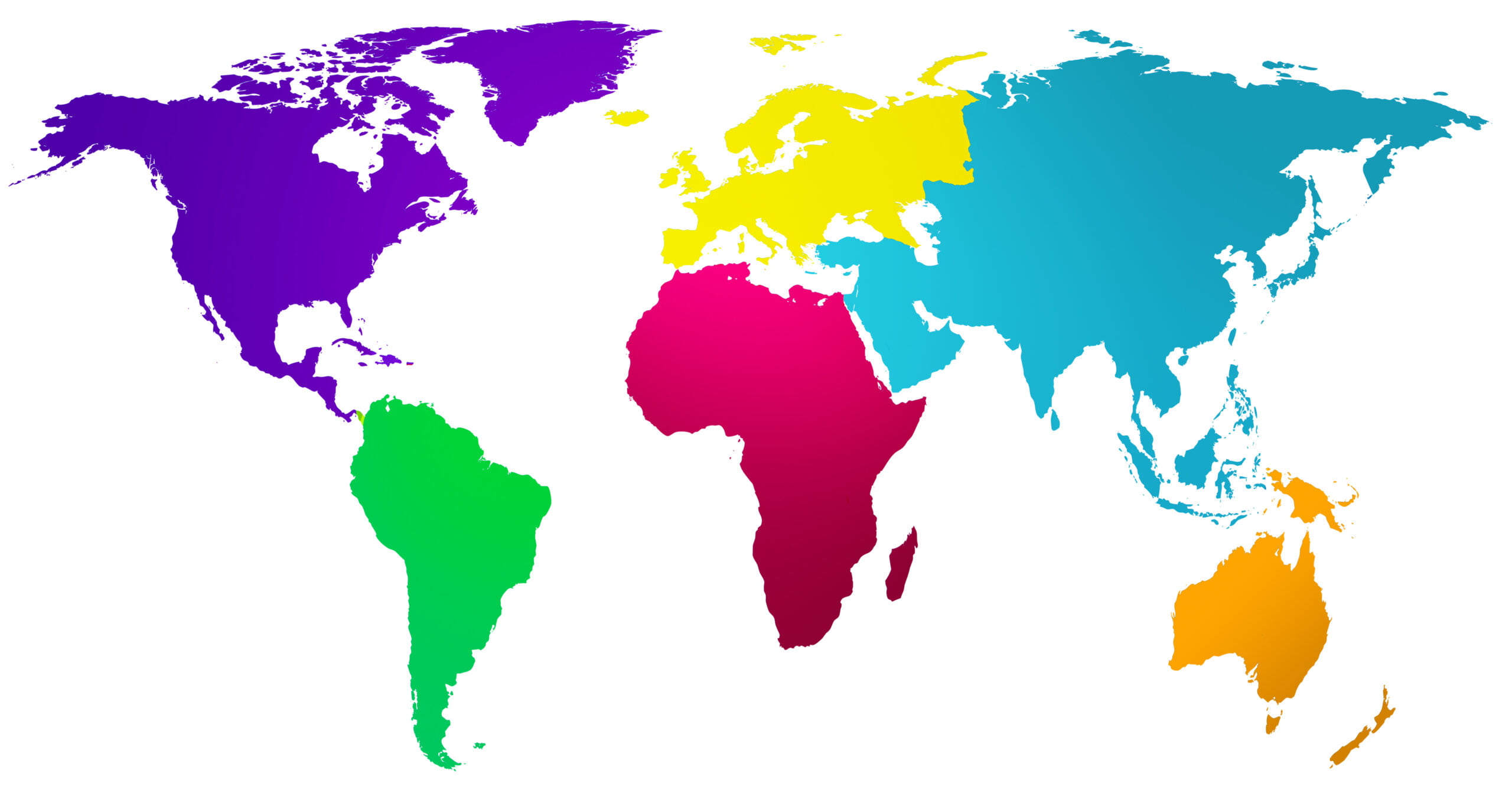The word “AIPAN (ऐपण)” is derived from the Sanskrit word ‘Arpan (अर्पण)’, which means ‘to write (लीपना)’. AIPAN is seen on the walls of every house in Uttarakhand, in the courtyard, on the sills, in places of worship.
To make Aipan art, the surface is smeared with ocher clay or geru (गेरू मिट्टी), which is red in color. The women then make beautiful designs and patterns with biswar (बिस्वार) made of rice. Women use their forefinger, ring finger, and middle finger to make designs and patterns.
Devbhoomi Uttarakhand is famous all over the world for its distinctive culture and artifacts, in these cultures “AIPAN” is also a major art. Which has great cultural and religious significance in every Kumaoni household.
History & Origin of Aipan Art
Aipan is one of the most traditional art forms of Kumaon that are popularly drawn at places of worship, house, and main entry doors. This artistic art form has great religious importance.
The beginning of Aipan practice started during the rule of the Chand dynasty in Kumaon. It originated in Almora (Uttarakhand) and since then with the migration of communities practicing this art, it has gradually made its way to many parts of the state.
Materials Used In Aipan Art
There are 2 main ingredients needed to make Aipan Art-
- Ochre Clay or Geru (गेरू मिट्टी)
- Rice paste (बिस्वार)
Aipan art is made on Ochre Clay, which is red in color. The women then make beautiful designs and patterns with biswar made of rice. Women use their forefinger, ring finger, and middle finger to make designs and patterns. The white design on a red background symbolizes fertility and luck for the family.
However, due to the advent of cement walls and floors, nowadays acrylic colors and synthetic enamel paints are used instead of geru mitti and biswar.
Different Types of Aipan Art
There are many types of Aipan in Uttarakhand and all of them serve different purposes. Such as – Chamunda Hasta Chowki (for Havan and Yagya), Saraswati Chowki (for education and learning), Nava Durga Chowki (for goddess worship), Janeu Chowki (for the thread-giving ceremony), and Asan Chowki (for ritual worship).
There are different designs of chowki according to different occasions. We have explained in detail the different types of Aipan art in Uttarakhand –
1. Saraswati Chowki (सरस्वती चौकी):

Saraswati is the goddess of learning, so a puja is conducted to give an auspicious start to formal education. The main feature of Saraswati Chowki is a five-pointed star with a swastika flower or diya in the center.
2. Chamunda Hasta Chowki (चामुंडा हस्त चौकी):

This Chowki is made for “Havan” or “Yagya”. Two triangles surrounded by a circle, with a 5-pointed star in the middle, with two diagonal lines running down the middle, form the center of this post. The spaces are filled with floral designs of the feet of Lakshmi. The chakra is often decorated with 8 petals of a lotus.
3. Nava Durga Chowki (नव दुर्गा चौकी):

This chowki is used for ritualistic goddess worship. The main points here are the nine points representing the Nava Durgas. Those who specialize in Aipan design make a square enclosing these points with crisscrossing parallel lines and decorate them with lotus petals. A simple way is to make a swastika with 9 points, it is called Nava Swastik. It has many forms. A simpler version is made by drawing three horizontal and vertical lines with a swastika in the center.
4. Shiva or Shivarchan Peeth (शिवार्चन पीठ):

In the month of Sawan or Magh, special worship is done to ‘Mahadev’, the God of Gods. 28 or 108 Parthiv Lingas are placed in a copper plate and a Shiva or Shivarchan Peeth is made on the ground. It is an eight-cornered design with 12 dots connected by 12 lines. To make it more attractive it has an outer boundary of four plus four corners.
5. Surya Darshan Chowki (सूर्य दर्शन चौकी):

This chowki is associated with the naming ceremony. For eleven days the infant is kept inside the house, on the eleventh day the infant is brought out for sun darshan. Where it is made on the post, the priests sit there and recite mantras.
6. Janeu Chowki (जनेऊ चौकी):

This Chowki is specially made for Janeu Sanskar (जनेऊ संस्कार). Seven stars form the main part of the six-sided picture. The seven stars represent the seven sages. Dotted floral designs are made around it.
7. Asan Chowki (आसन चौकी):

It is associated with several types of Chowki used for different pujas. It is a decorated seat for the devotee and his wife for ritualistic worship.
8. Dhuli Arghya Chowki (धूलि अर्घ्य चौकी):

Dhuliargh’s post is made on the first arrival of the Groom (दूल्हा) in marriage, this post is made by marking it in the courtyard of the girl’s side.
Sun, moon, conch shell, and bell, are made in the form of witnesses in big size in Dhuli Arghya Chowki. It is made in four rows of four making the swastika symbol. The square circle is enclosed in a circular circle in such a way that it takes the shape of a vase. Then it is shown to be installed on a lotus flower, in which the seat under the vase is installed in a lotus flower. The shape of the urn becomes clear by giving a face on its upper part, making two horizontal lines on the face of the urn, and making it complete by giving it a garland-like shape.
9. Acharya Chowki (आचार्य चौकी):

In marriage, the Pandit or Acharya is given more importance than the father of the groom. That’s why a special post is made for them. Swastik is made on it with red color. Lotus and other auspicious symbols like bell, conch shell, and sometimes 2 parrots are also depicted around the swastika.
10. Durga Thapa (दुर्गा थापा):

Durga Thapa is painted on paper by the women of Kumaon for the two Durga Pujas held during the year, one in March-April and the other before the festival of Dussehra. The puja lasts for nine days and hence it is called Navratras.
Durga Thapa depicts the image of goddess Durga riding a lion as well as images of many deities including many local deities. The background is beautifully decorated with motifs of auspicious symbols like conch shell, bells, flowers, tulsi leaves, rice grains, eight-petalled lotus, and swastika. The top row of the arrangement is dedicated to the Sun.
11. Jyoti Patta (ज्योति पत्ता):

In the hills of Kumaon, there is a custom of taking out “Jyoti” at marriage or sacred thread ceremony among Brahmin and Sah families. In earlier times, “Jyotis” were frescoes painted on the walls of rooms where religious ceremonies took place. “Jyoti” is the local term used for the Jiva Matrikas – Maha Lakshmi, Maha Saraswati and Maha Kali.
The depiction of “Jyanti” or Jyoti Patta follows a pattern. Himalaya is depicted in the first line because it is customary to send the first invitation to him. This is followed by lines of floral or geometric designs. An important panel has two lotuses on either side and a tree symbolizing the mythological Kalpavriksha. Brahma, the creator, and Vishnu, the preserver, are said to reside in the roots of the tree, Shiva, the destroyer, in its trunk, and his consort, Parvati, in the topmost part of the tree. Under the tree, two parrots are painted for luck. In the center of the panel are the figures of Radha-Krishna or Ganesha and Riddhi or even the bride and groom. The main panel has three matrikas which include Ganesha. At the top, there are two circular faces of Anyari Devi and Ujyari Devi, the presiding deities of light and darkness. The central panel has an elaborate design of ranking points and lines called “bar drops”. It also represents an invitation as well as an invocation of the deities to attend the wedding and bless the couple.
12. Lakshmi Yantra (लक्ष्मी यंत्र):

Like other parts of India, in the hills of Kumaon, Lakshmi, the goddess of wealth, is worshiped during the festival of Diwali. Before placing the idol in the place where the puja will take place, a Lakshmi Yantra is made on the floor with ocher color (geru) and rice paste (biswar). This is the place of the Goddess.
Aipan Art Gets GI Tag
Aipan Art, a traditional folk art form of Uttarakhand, India, has been granted the prestigious Geographical Indication (GI) tag.
Aipan Art holds deep cultural and historical significance, characterized by intricate geometric patterns and vibrant colors. With the GI tag, the traditional artisans and communities involved in creating Aipan Art will receive recognition and economic benefits, while preserving and promoting their rich cultural heritage for generations to come.
What is GI Tag?
GI Tag stands for Geographical Indication Tag, also known as Geographical Indication (GI) protection. It is a form of intellectual property right that is used to indicate the geographical origin of certain products. This tag is applied to products that have specific qualities, characteristics, or reputations associated with their place of origin.
Do you know: Darjeeling Tea was the first Indian product to be labeled as a GI product.
What are the Benefits of the GI tag?
Obtaining a Geographical Indication (GI) tag for a product offers various benefits, both to producers and consumers. Here’s a list of some of the advantages of having a GI tag:
- Consumers can trust that GI-tagged products are genuinely tied to their specific geographical region of origin.
- Producers from designated regions gain a competitive advantage, leading to increased sales and economic growth.
- GI tags contribute to preserving and promoting the traditional knowledge and practices associated with the product.
- GI-tagged products become attractive to consumers seeking unique and authentic offerings, expanding market opportunities.
- GI tags attract tourists to visit regions associated with the product, boosting tourism and local businesses.
- GI tags encourage the continuation of traditional methods and expertise linked to the product.
List of Uttarakhand products that have received GI Tag
| Category | Products |
| Handicraft | Bhotia Dann |
| Art | Aipan Art |
| Agriculture | Munsyari Razma |
| Handicraft | Uttarakhand Tamta Product |
| Handicraft | Thulma Blanket |
| Handicraft | Ringal Craft |
| Agriculture | Kumaon Chyura Oil |
Aipan Girl of Uttarakhand – Promoting Traditional Art and Empowering Women
Minakshi Khati, popularly known as the ‘Aipan Girl,’ is a 24-year-old artist hailing from the picturesque town of Nainital in Uttarakhand, India. Her passion for the traditional Kumaoni art form, Aipan, has led her on a remarkable journey of preserving and promoting this ancient art while empowering local women and artists.
Through her initiative, ‘Minakrti: The Aipan Project,’ she has been able to bring new life to the art form, incorporating modern elements while cherishing its authentic essence.
Images used in this article are sourced from social media. All rights and credits to the respective owners.



